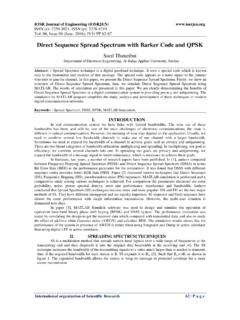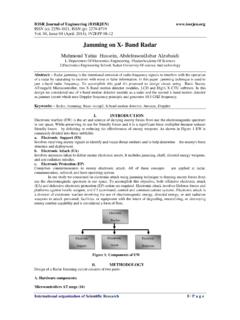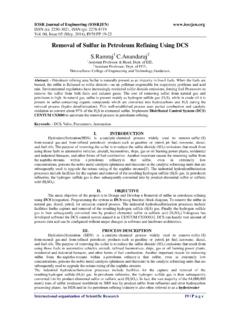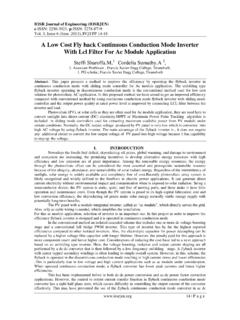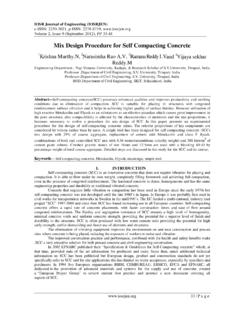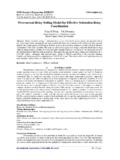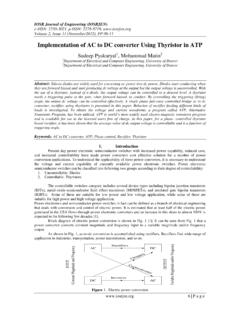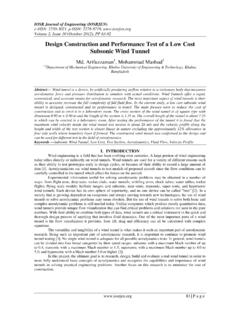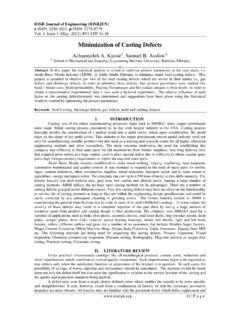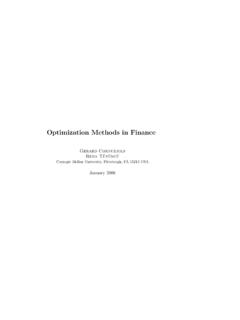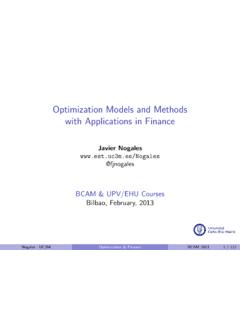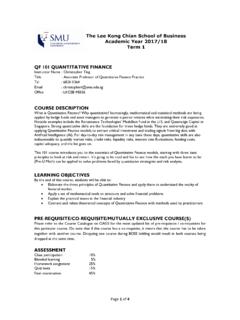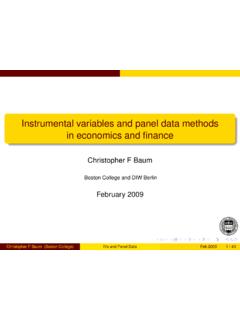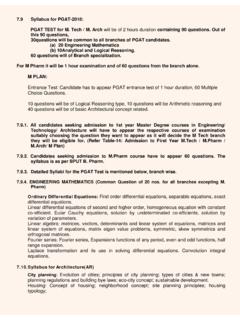Transcription of Modeling and Optimization of the Compressive Strength of ...
1 IOSR Journal of Engineering (IOSRJEN) ISSN (e): 2250-3021, ISSN (p): 2278-8719. Vol. 05, Issue 05 (May. 2015), ||V3|| PP 74-86. Modeling and Optimization of the Compressive Strength of Latertic Concrete Using Scheffe's Theory Onuamah Civil Engineering Department, Enugu State University of Science and Technology, Enugu, Nigeria. Abstract: - The paper presents the report of an investigation carried out to model and optimize the Compressive Strength of Lateritic Concrete. The laterite is the reddish soil layer often belying the top soil in many locations and further deeper in some areas, collected from the Vocational Education Building Site of the University of Nigeria, Nsukka. The work applied the Scheffe's Optimization approach to obtain a mathematical model of the form f(xi1,xi2,xi3), where xi are proportions of the concrete components, viz: cement, laterite and water.
2 Scheffe's experimental design techniques are followed to mould various block samples measuring 220mm x 210mm x 120mm, with varying generated components ratios which were tested for 28 days Strength . To carry out the task, we embark on experimentation and design, applying the second order polynomial characterization process of the simplex lattice method. The model adequacy is checked using the control factors. Finally a software is prepared to handle the design computation process to select the optimized properties of the mix, and generate the optimal mix ratios for the desired property. Keywords: Concrete, laterite, pseudo-component, Simplex-lattice, model. I. INTRODUCTION. The construction of structures is a regular operation which creates the opportunity for continued change and improvement on the face of the environment.
3 From the beginning of time, the cost of this change has been of major concern to man as the major construction factors are finance, labour, materials and equipment. Major achievements in the area of environmental development is heavily dependent on the availability of construction materials which take a high proportion of the cost of the structure. This means that the locality of the material and the usability of the available materials directly impact on the achievable development of the area as well as the attainable level of technology in the area. In the present time, concrete is the main material of construction, and the ease or cost of its production accounts for the level of success in the of area environmental upgrading through the construction of new roads, buildings, dams, water structures and the renovation of such structures.
4 To produce the concrete several primary components such as cement, sand, gravel and some admixtures are to be present in varying quantities and qualities. Unfortunately, the occurrence and availability of these components vary very randomly with location and hence the attendant problems of either excessive or scarce quantities of the different materials occurring in different areas. Where the scarcity of one component prevails exceedingly, the cost of the concrete production increases geometrically. Such problems obviate the need to seek alternative materials for partial or full replacement of the component when it is possible to do so without losing the quality of the concrete. Optimization Concept Every activity that must be successful in human endeavour requires planning. The target of planning is the maximization of the desired outcome of the venture.
5 In order to maximize gains or outputs it is often necessary to keep inputs or investments at a minimum at the production level. The process involved in this planning activity of minimization and maximization is referred to as Optimization , (Orie and Osadebe , 2009). In the science of Optimization , the desired property or quantity to be optimized is referred to as the objective function. The raw materials or quantities whose amount of combinations will produce this objective function are referred to as variables. The variations of these variables produce different combinations and have different outputs. Often the space of variability of the variables is not universal as some conditions limit them. These conditions are called constraints. For example, money is a factor of production and is known to be limited in supply.
6 The constraint at any time is the amount of money available to the entrepreneur at the time of investment. Hence or otherwise, an Optimization process is one that seeks for the maximum or minimum value and at the same time satisfying a number of other imposed requirements (Majid, , 1974). The function is called the objective function and the specified requirements are known as the constraints of the problem. Everybody can make concrete but not everybody can make structural concrete. Structural concrete are made with specified materials for specified Strength . Concrete is heterogeneous as it comprises sub-materials. International organization of Scientific Research 74 | P a g e Modeling and Optimization of the Compressive Strength of Latertic Concrete Using Scheffe's Theory Concrete is made up of fine aggregates, coarse aggregates, cement, water, and sometimes admixtures.
7 David and Galliford (2000), report that modern research in concrete seeks to provide greater understanding of its constituent materials and possibilities of improving its qualities. For instance, Portland cement has been partially replaced with ground granulated blast furnace slag (GGBS), a by product of the steel industry that has valuable cementations properties (Ecocem Ireland Ltd, 1993). Concrete Mix Optimization The task of concrete mix Optimization implies selecting the most suitable concrete aggregates from the data base (Genadij and Juris, 1998). Several methods have been applied. Examples are by Mohan (2002), Simon (2003), Lech (1999), Czarneki (1994). Nordstrom and Munoz (1994) proposed an approach which adopts the equilibrium mineral assemblage concept of geochemical thermodynamics as a basis for establishing mix proportions.
8 Bloom and Bentur (1995) reports that Optimization of mix designs require detailed knowledge of concrete properties. Low water-cement ratios lead to increased Strength but will negatively lead to an accelerated and higher shrinkage. Apart from the larger deformations, the acceleration of dehydration and Strength gain will cause cracking at early ages. Modeling means setting up mathematical models/formulations of physical or other systems. Many factors of different effects occur in nature in the world simultaneously dependently or independently. When they interplay they could inter-affect one another differently at equal, direct, combined or partially combined rates variationally, to generate varied natural constants in the form of coefficients and/or exponents. The challenging problem is to understand and asses these distinctive constants by which the interplaying factors underscore some unique natural phenomenon towards which their natures tend, in a single, double or multi phase system.
9 For such assessment a model could be constructed for a proper observation of response from the interaction of the factors through controlled experimentation followed by schematic design where such simplex lattice approach of the type of Henry Scheffe (1958) Optimization theory could be employed. Also entirely different physical systems may correspond to the same mathematical model so that they can be solved by the same methods. This is an impressive demonstration of the unifying power of mathematics (Erwin Kreyszig, 2004). II. LITERATURE REVIEW. To be a good structural material, the material should be homogeneous and isotropic. The Portland cement, laterite or concrete are none of these, nevertheless they are popular construction materials (Wilby, 1963). laterized concrete can be used in constructing cylindrical storage structures (Ukamaka , 2007).
10 With given proportions of aggregates the Compressive Strength of concrete depends primarily upon age, cement content, and the cement-water ratio (Reynolds, C. and Steedman, , 1981). Tropical weathering (laterization) is a prolonged process of chemical weathering which produces a wide variety in the thickness, grade, chemistry and ore mineralogy of the resulting soils (Tardy, Yves - 1997). The mineralogical and chemical compositions of laterites are dependent on their parent rocks (Tardy Yves, 1997). Laterite formation is favoured in low topographical reliefs of gentle crests and plateaus which prevent the erosion of the surface cover (Dalvi, Ashok D.; Bacon, W. Gordon; Osborne, Robert C. (March 7 10, 2004)). Laterites reflect past weathering conditions (Helgren, David M.; Butzer, Karl W. Butzer, October 1977).
